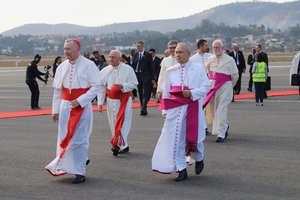Six Retired Jesuits Died of Coronavirus at Order’s Philadelphia Infirmary
There were 17 Jesuits who lived at the facility’s infirmary, and all of them had tested positive for COVID-19 April 17.

DENVER, Colo. — Six retired Jesuit priests who resided at an infirmary of the society in Philadelphia died last month of coronavirus.
The priests lived at Manresa Hall, the infirmary at Saint Joseph’s University’s Loyola Jesuit Residence. They died at local hospitals between April 14 and 28.
The facility had been temporarily evacuated. It reopened April 25, and “the residents at Manresa are now all in stable condition,” Mike Gabriele, spokesman for the Society of Jesus’ East Coast province, told CNA.
There were 17 Jesuits who lived at the facility’s infirmary, and all of them had tested positive for COVID-19 April 17 - three days after the death of the first priest, Father G. Richard Dimler, 88, who taught computer science and German at Fordham University.
The deaths also included Francis Moan, 93, a former headmaster for Maryland’s Loyola Blakefield prep school; John Lange, 93, a counselor for the University of Scranton; Edward Dougherty, 79, who taught at the Theological Institute in South Africa; John Kelly, 77, a campus minister for Georgetown University; and Michael Hricko, 77, who ministered to his Jesuit brothers at Manresa Hall nursing center.
Gabriele said the facility is following the proper safety regulations, including protective gear for employees and consistent monitoring of the residents. He said the Jesuit community is grieving over the loss of their brothers and will continue to pray for those affected by the virus.
“All suspect COVID-19 cases are being monitored and appropriately managed at all Jesuit communities, and personal protective gear has been supplied to protect staff and residents at our health centers,” Gabriele said.
“The Jesuits mourn the loss of their brothers who have died, and they continue to pray for all those struggling with the Coronavirus and their caregivers.”
- Keywords:
- 6
- coronavirus
- died
- philadelphia
- priests















